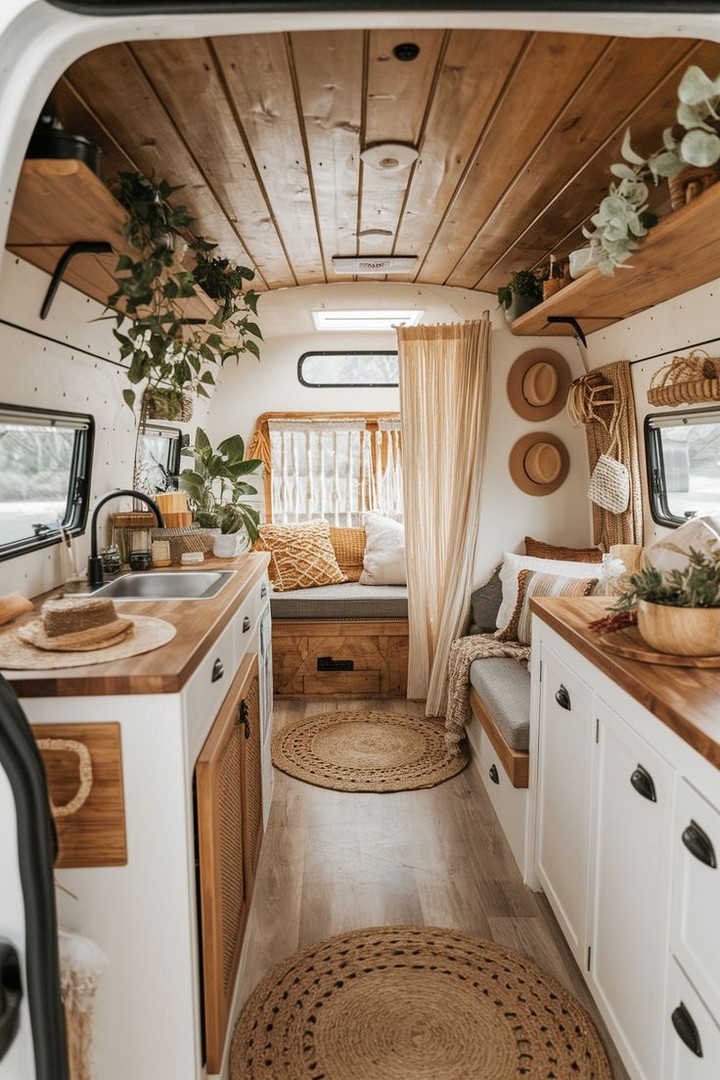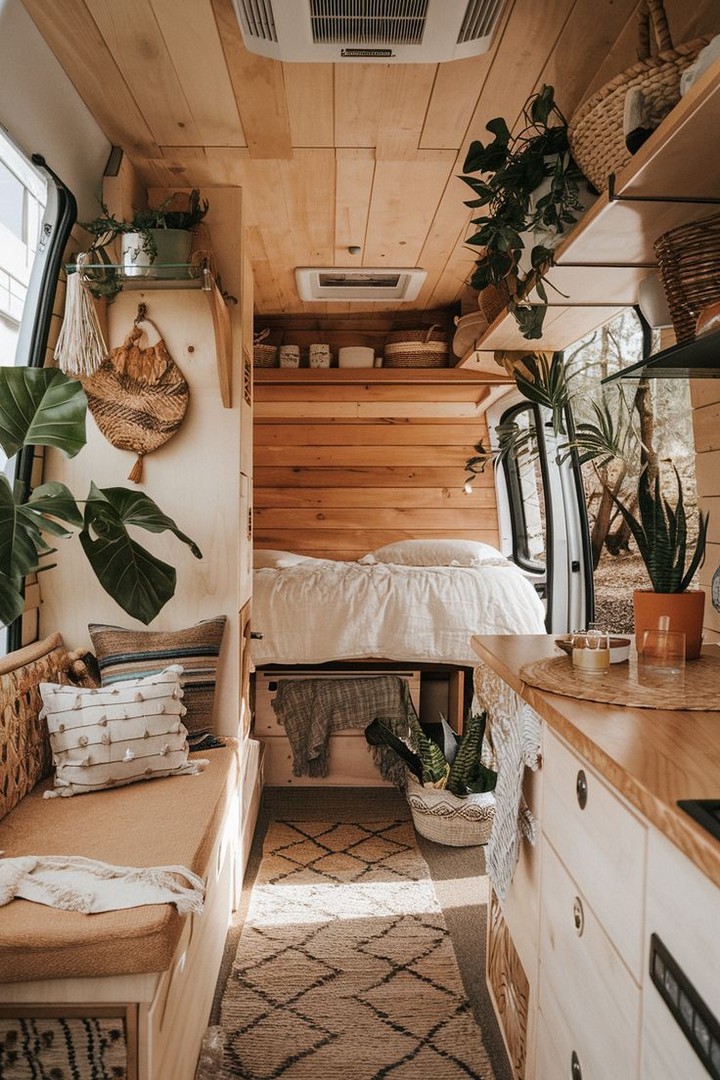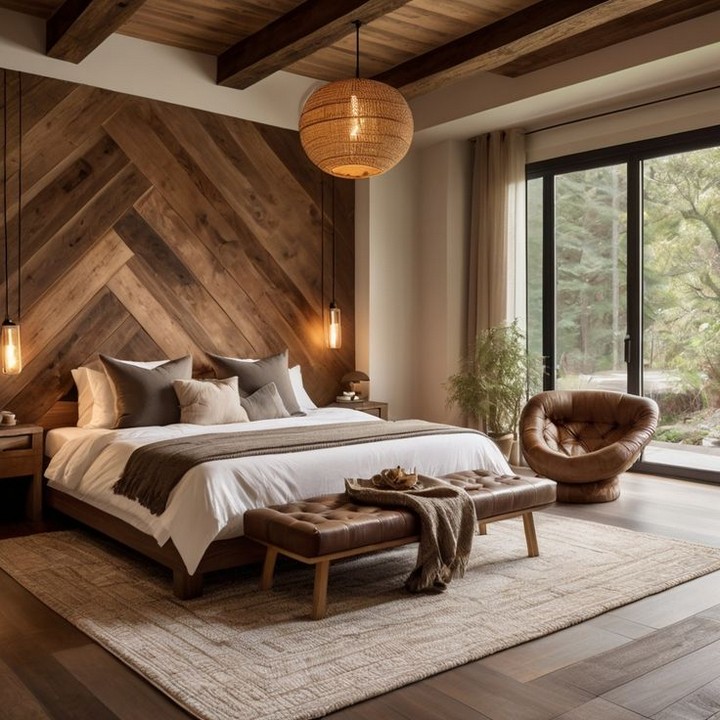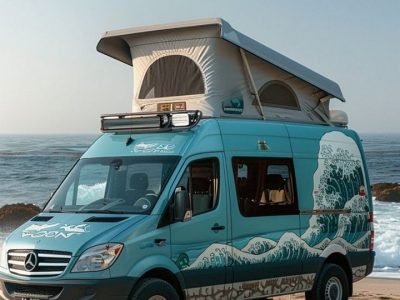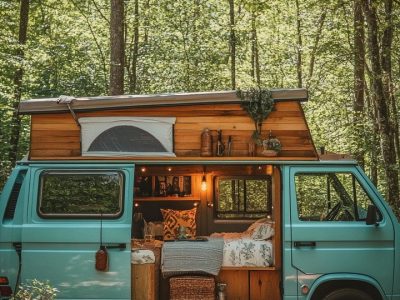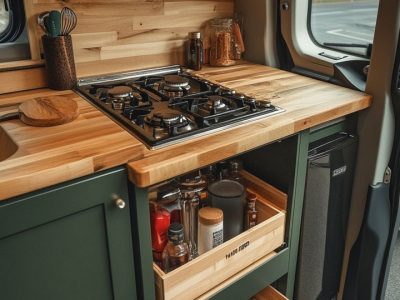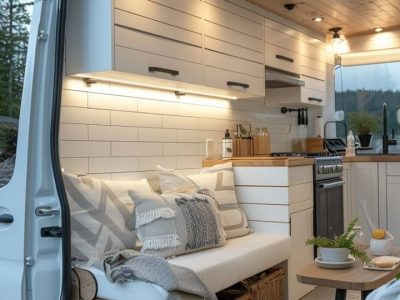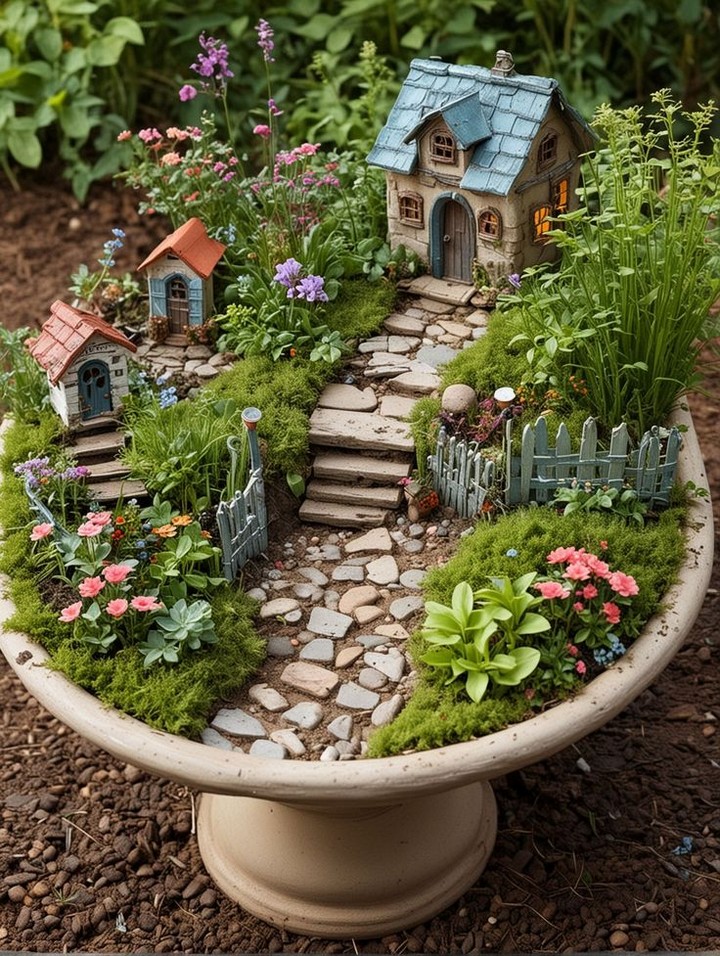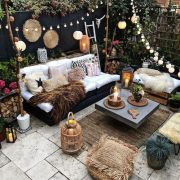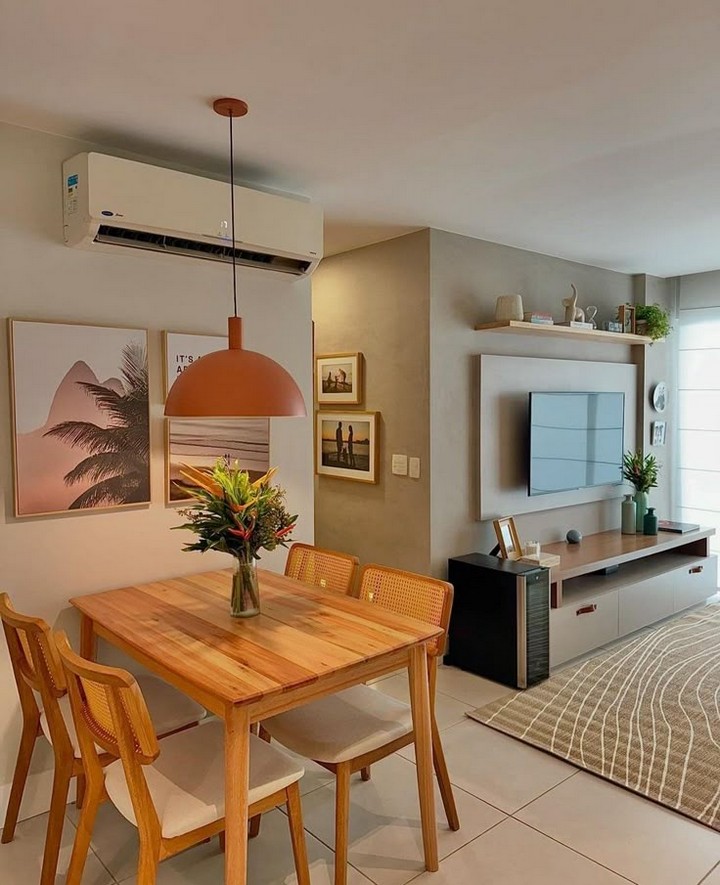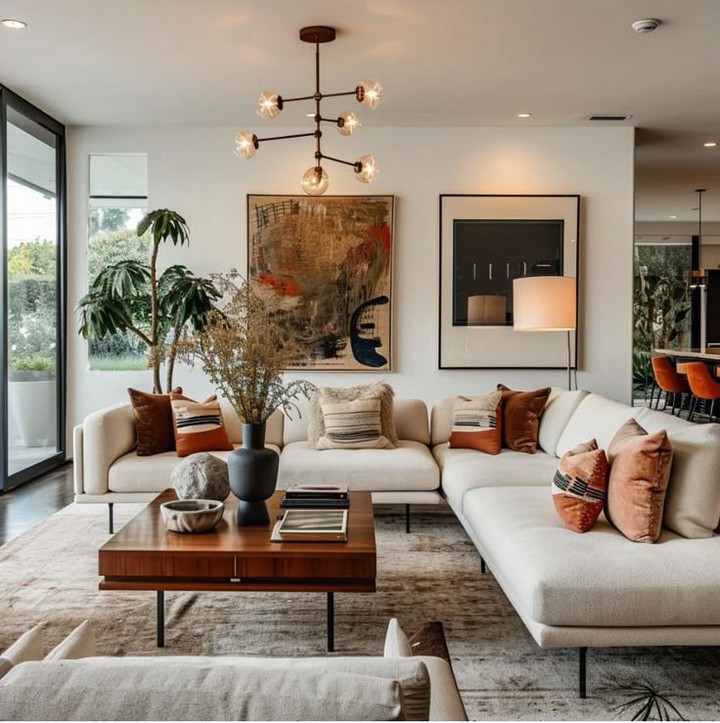Transform your van into a beautiful, functional tiny home with these inspiring minimalist design approaches.
The Art of Minimalist Van Living
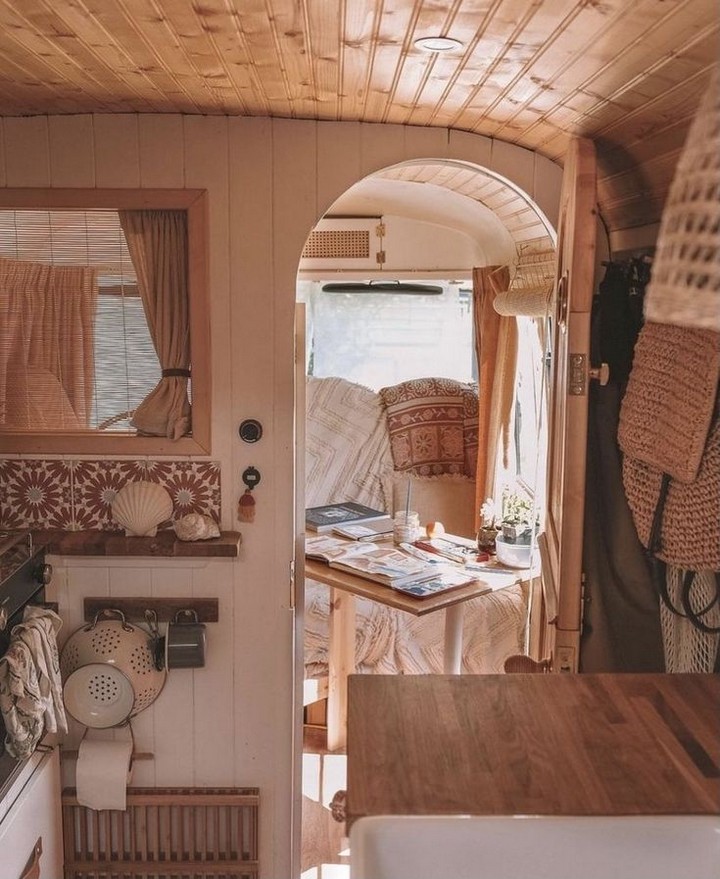
The minimalist van conversion movement has revolutionized mobile living, proving that limited space doesn’t mean limited style. By embracing thoughtful design principles and focusing on what truly matters, van dwellers are creating stunning mobile sanctuaries that feel spacious, functional, and deeply personal.
This comprehensive guide explores 22 distinct minimalist van aesthetics that can transform your vehicle into a beautiful tiny home. Whether you’re planning your first conversion or looking to refresh your current setup, these design approaches offer inspiration while maintaining the core principles of minimalism: simplicity, functionality, and intentionality.
Why Minimalism Works Perfectly for Van Conversions

Minimalism isn’t just an aesthetic choice for van conversions it’s a practical necessity. Limited square footage demands thoughtful curation of possessions and intelligent use of space. However, minimalist design goes beyond mere utility. It creates visual spaciousness through clean lines and uncluttered surfaces that make small spaces feel larger. It promotes mental clarity by reducing visual noise and contributing to a sense of calm. Functional efficiency becomes paramount as every item serves a purpose, often multiple purposes. Sustainability naturally follows with reduced consumption meaning a smaller environmental footprint. Ultimately, minimalism provides freedom as fewer possessions translate to more flexibility and mobility.
Now, let’s explore the 22 most inspiring minimalist van conversion aesthetics that blend form and function seamlessly.
1. Scandinavian Simplicity
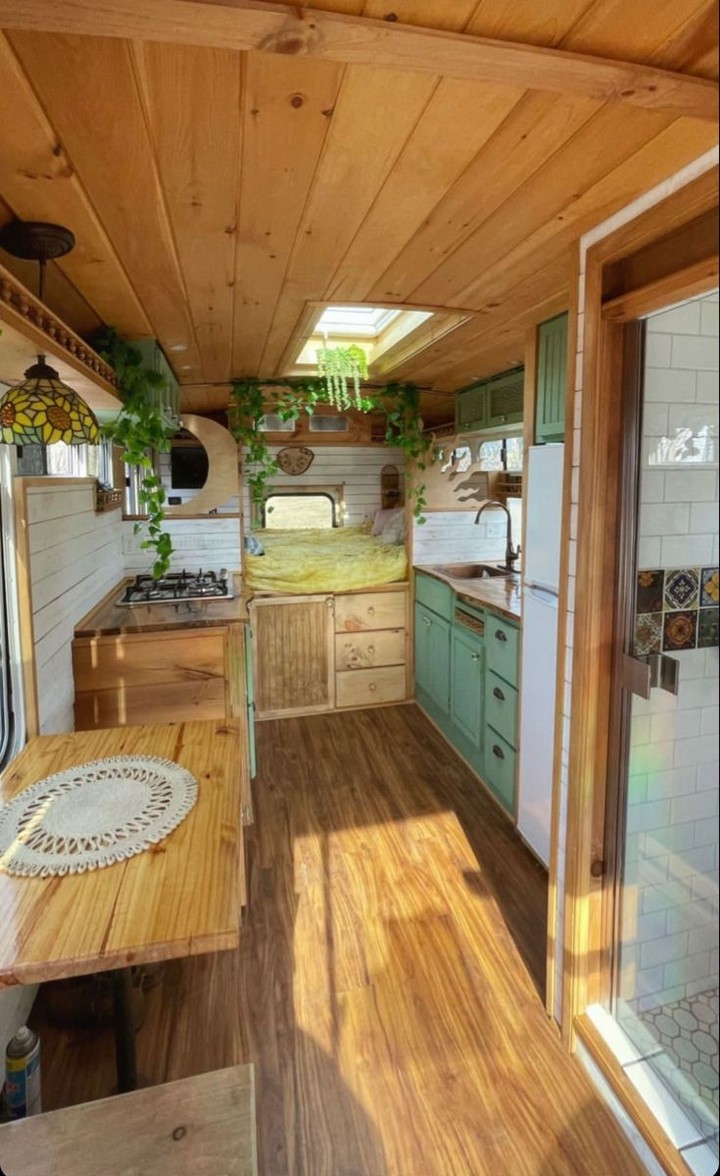
The Scandinavian aesthetic embodies minimalism through clean lines, natural materials, and a predominantly white color palette that maximizes the perception of space. Pale wood finishes like birch, pine, or ash complement white walls and cabinetry, creating an airy atmosphere even in compact spaces. Simple textile patterns in neutral tones add visual interest without overwhelming the space, while functional furniture with hidden storage solutions maintain the clean aesthetic. Scandinavian van designs prioritize natural light, often using minimal window treatments to let sunshine flood the interior, creating a bright, welcoming environment that feels more spacious than its actual dimensions.
2. Japanese-Inspired Zen

Japanese design principles inspire the Zen aesthetic, creating tranquil, deliberately sparse interiors focused on balance and harmony. Low-profile furniture keeps the space open and uncluttered, while natural materials like bamboo and simple textiles add warmth without visual complexity. Space division comes through elegant solutions like sliding doors or curtains that can be adjusted as needed. The color palette typically features earthy, muted tones that create a grounding atmosphere. Many Zen van conversions incorporate small plant elements to bring nature inside. This aesthetic embraces the concept of “ma” (negative space), allowing room to breathe and creating a meditative atmosphere perfect for long journeys.
3. Industrial Minimalism
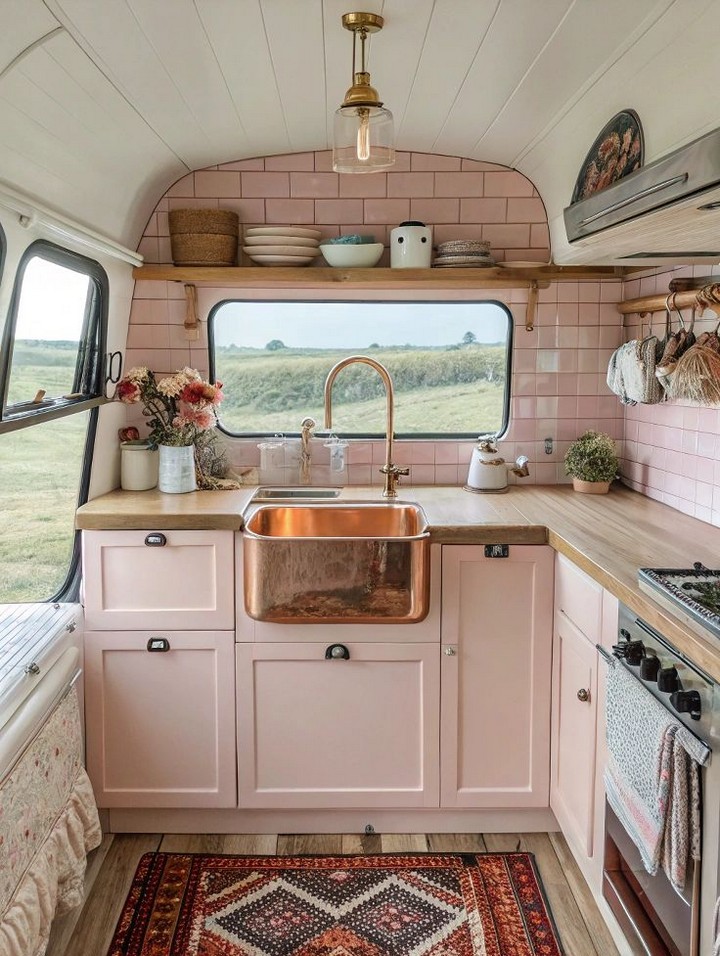
Industrial minimalism marries raw materials with clean design, creating a rugged yet refined aesthetic that celebrates structural elements rather than hiding them. Exposed metal elements and fixtures become design features rather than merely functional components. Surfaces might feature concrete-look finishes or actual concrete elements, balanced with warmer touches of wood. The color palette leans toward cool grays, blacks, and browns with strategic pops of color. Lighting plays a crucial role, with statement fixtures often becoming focal points. This style embraces the inherent “unfinished” quality of industrial spaces while maintaining the clean lines and purposeful design of minimalism.
4. Coastal Minimalism
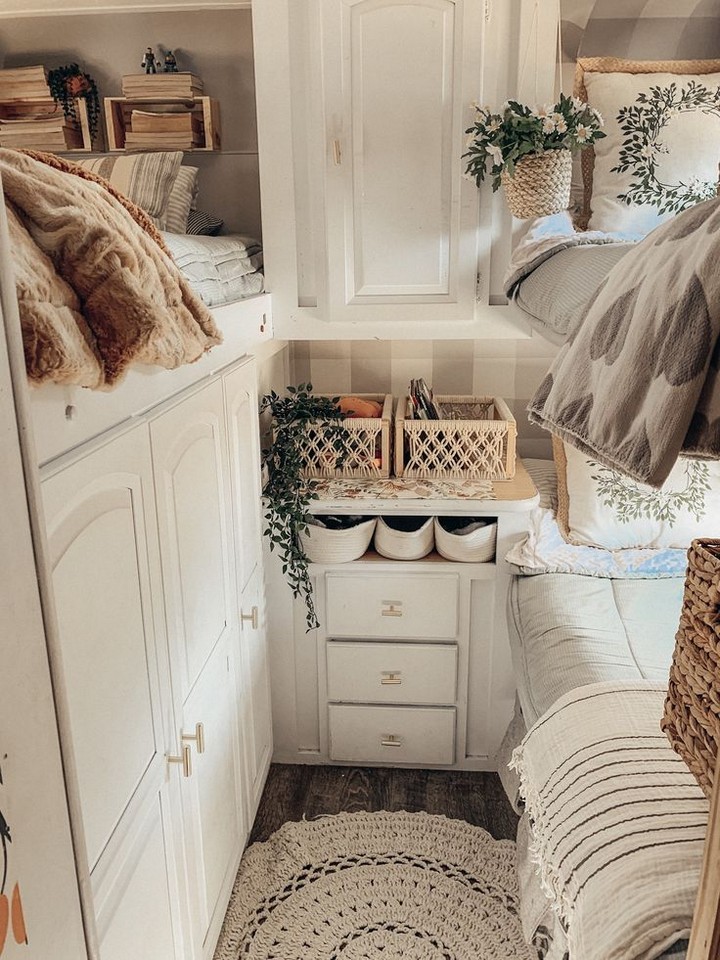
Coastal minimalism captures the essence of beachside living through a pared-down lens. Light, breezy color palettes predominantly feature whites, creams, and soft blues that evoke sky and sea. Natural light is maximized to create the sense of openness associated with shoreline environments. Textiles and accessories incorporate subtle nautical motifs without becoming kitschy think elegant rope details or subdued wave patterns rather than obvious anchors and shells. Materials tend toward those found in beach environments: weathered woods, jute, and canvas. The overall effect is refreshing and open, creating a sense of perpetual vacation regardless of where the van is parked.
5. Bohemian Minimalism
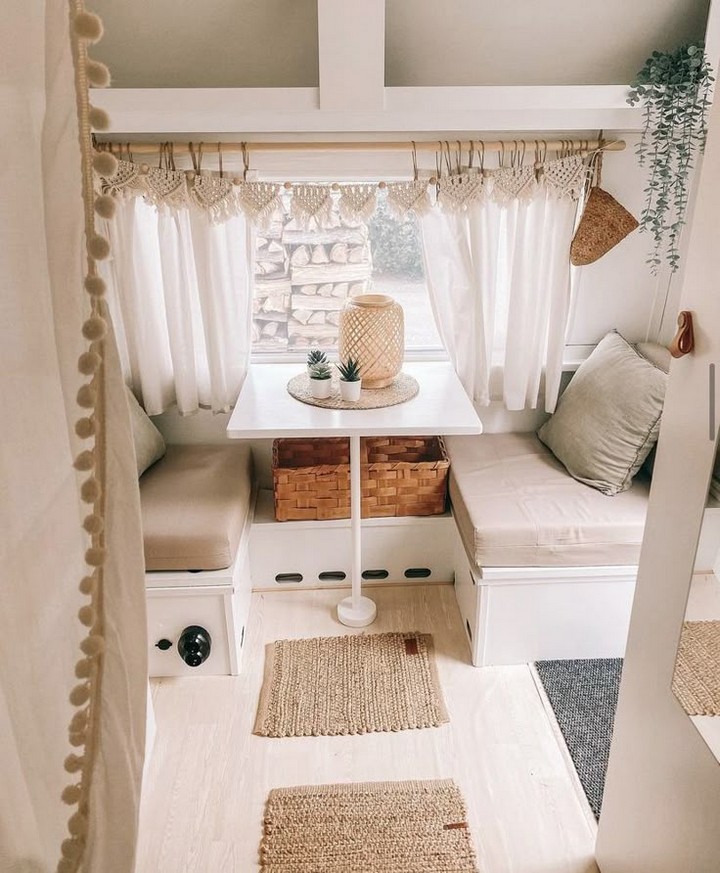
Bohemian minimalism blends the free-spirited bohemian aesthetic with minimalist restraint. Rather than the visual abundance of traditional boho style, this approach carefully curates textiles and decorative elements. A neutral base palette allows select vibrant textiles and plants to stand out as intentional focal points. Natural materials dominate, with rattan, macramé, and global-inspired textiles adding texture and interest. Personal mementos and handcrafted items tell a story without creating clutter. The space feels well-traveled and personal while maintaining the breathing room essential to minimalist design.
6. Modern Rustic
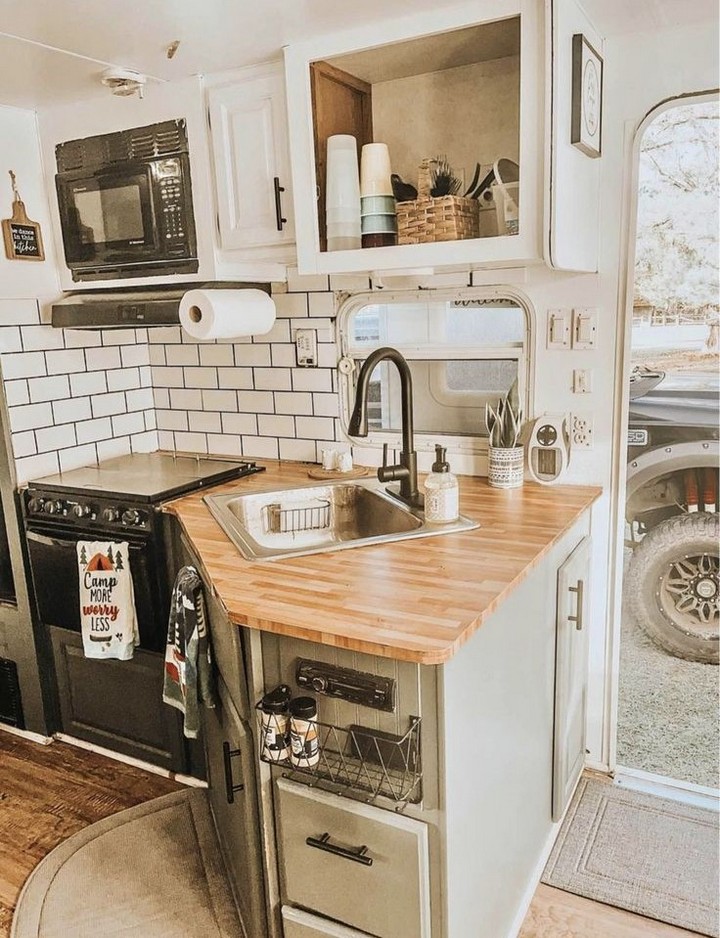
Modern rustic combines contemporary minimalism with rustic warmth, creating spaces that feel both current and timeless. Reclaimed wood becomes a signature element, often used for statement walls, countertops, or custom furniture pieces. The color palette centers around warm neutrals with black accents for contrast and definition. Contemporary fixtures and hardware provide a modern counterpoint to natural materials. Modern rustic van conversions often incorporate traditional craftsmanship techniques with clean, current designs. The result is a space that feels connected to nature and crafting traditions while embracing modern efficiency and aesthetic simplicity.
7. Monochromatic Minimalism
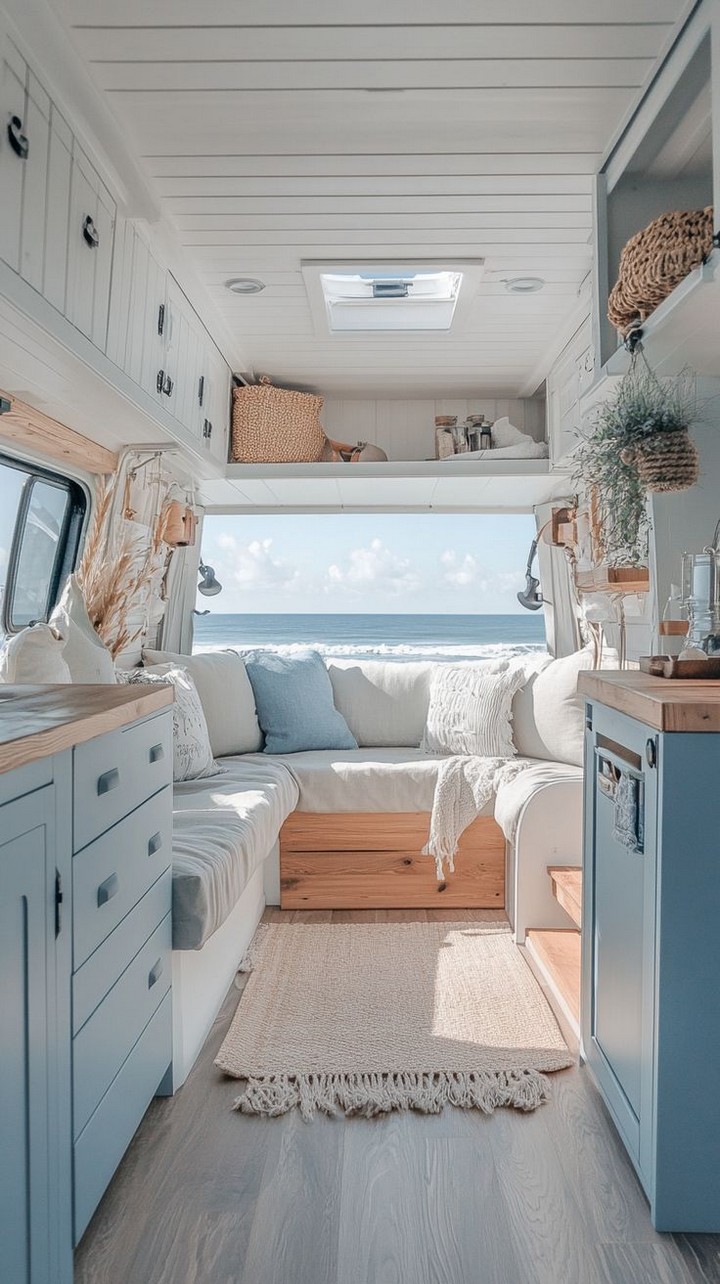
Monochromatic minimalism creates cohesion through limited color variation, typically focusing on different shades and textures of a single color family. This approach creates a sophisticated, harmonious environment where subtle variations become the visual interest. White monochromatic schemes make small spaces feel expansive, while darker monochrome palettes create cozy, enveloping environments. Texture becomes paramount in these designs, with different finishes and materials providing depth and dimension. This aesthetic works particularly well in van conversions, where visual continuity helps small spaces feel more cohesive and intentionally designed.
8. Wabi-Sabi Minimalism
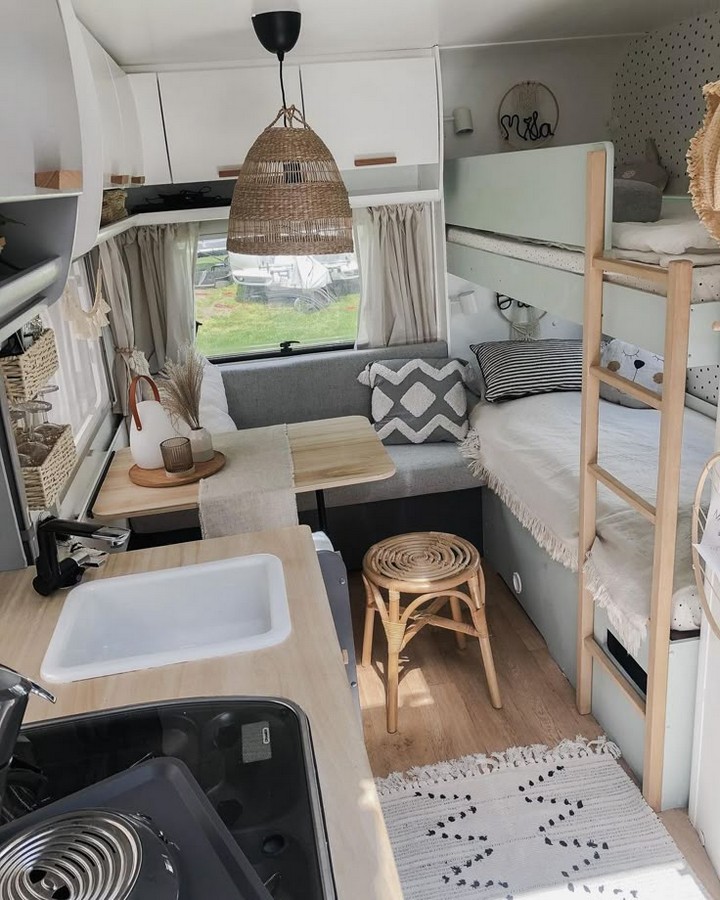
Wabi-sabi minimalism embraces imperfection and authenticity, celebrating the beauty of natural aging and subtle imperfections. This Japanese-inspired aesthetic values handcrafted and imperfect elements over machine-made perfection. Natural, unfinished materials show their inherent character, while simple, asymmetrical arrangements create balance without rigidity. The color palette features earth tones and naturally occurring colors. Wabi-sabi van conversions feel deeply personal and soulful, with a lived-in quality that develops naturally over time. This approach particularly suits those who value authenticity and organic evolution over pristine perfection.
9. Eco-Minimalism
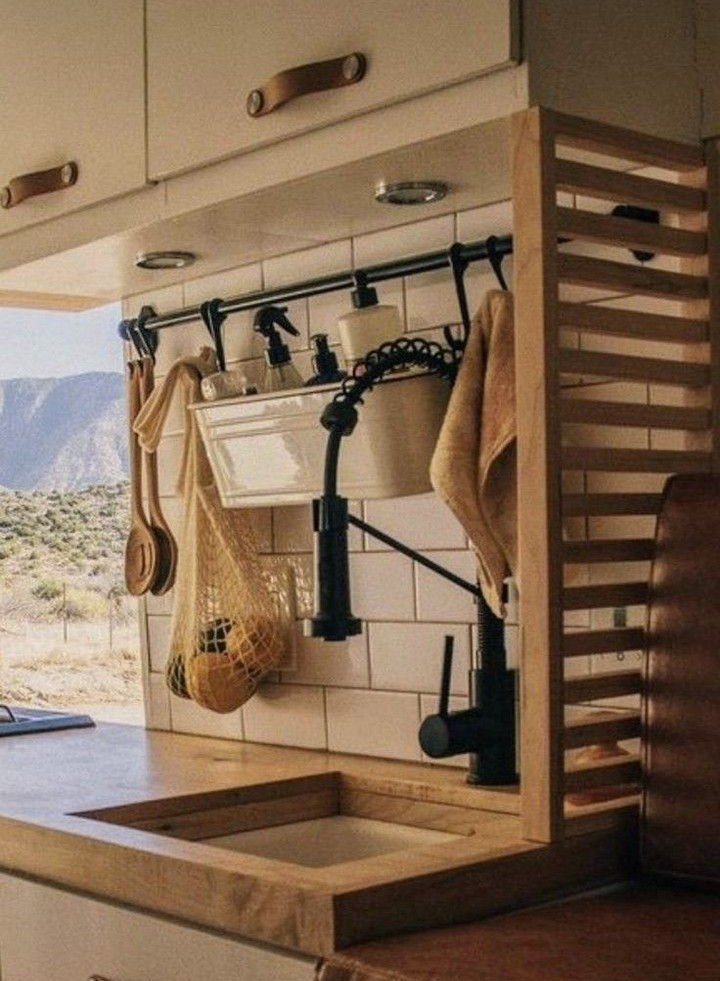
Eco-minimalism prioritizes sustainable materials and environmentally conscious choices while maintaining minimalist principles. Reclaimed, recycled, and sustainable materials form the foundation of these conversions. The aesthetic often incorporates visible natural elements like living plants, which simultaneously improve air quality and connect the space to nature. Energy-efficient solutions are integrated into the design rather than added as afterthoughts. The color palette typically draws from nature, with forest greens, sky blues, and earthy browns. These conversions tell a story of environmental consciousness without sacrificing style or comfort.
10. Nordic Noir
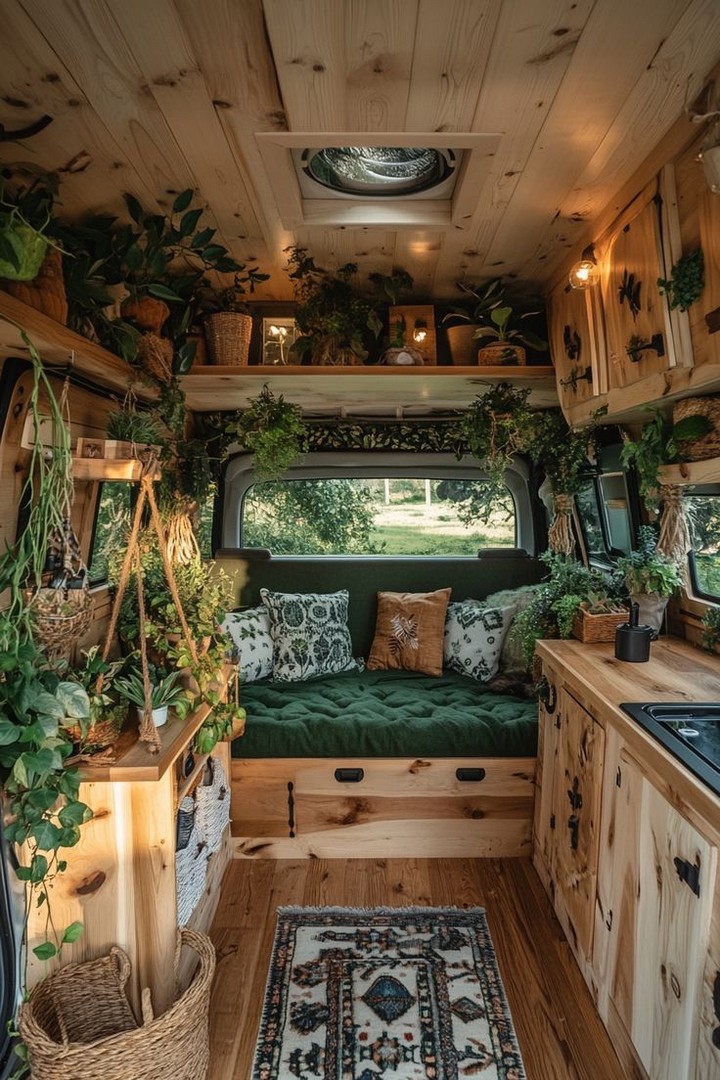
Nordic Noir takes the lightness of typical Scandinavian design and infuses it with drama through deeper tones and more contrast. Black, charcoal, and deep navy create sophisticated backdrops, while light woods and white elements provide necessary contrast. Texture plays a crucial role, with soft textiles balancing harder surfaces. Lighting becomes particularly important, with warm-toned fixtures creating ambiance against darker backgrounds. This aesthetic creates a cozy yet refined atmosphere that feels particularly suited to evening relaxation and moody weather days on the road.
11. Japandi Fusion
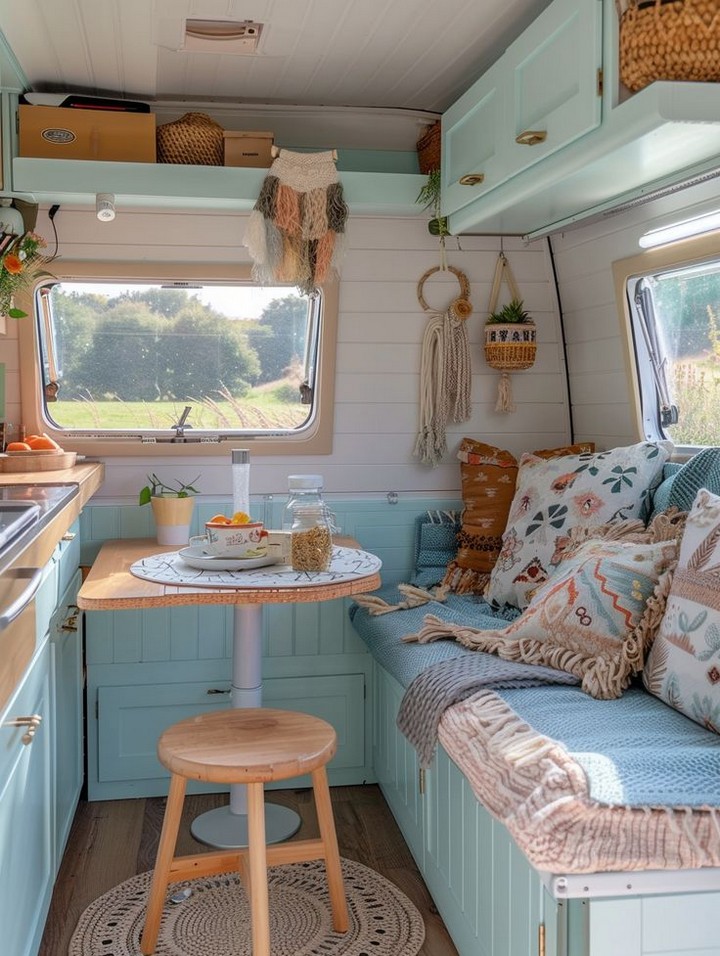
Japandi fusion combines Japanese and Scandinavian design principles to create spaces that feel both warm and minimal. This hybrid style pairs the functionality and light woods of Scandinavian design with the organic shapes and philosophies of Japanese aesthetics. Natural materials dominate, but with a restrained approach to their use. The color palette tends toward neutral with subtle earth tones. Craftsmanship and quality are emphasized over quantity, with each piece serving both functional and aesthetic purposes. Japandi van conversions feel particularly harmonious, balancing warmth and minimalism in equal measure.
12. Minimalist Vintage
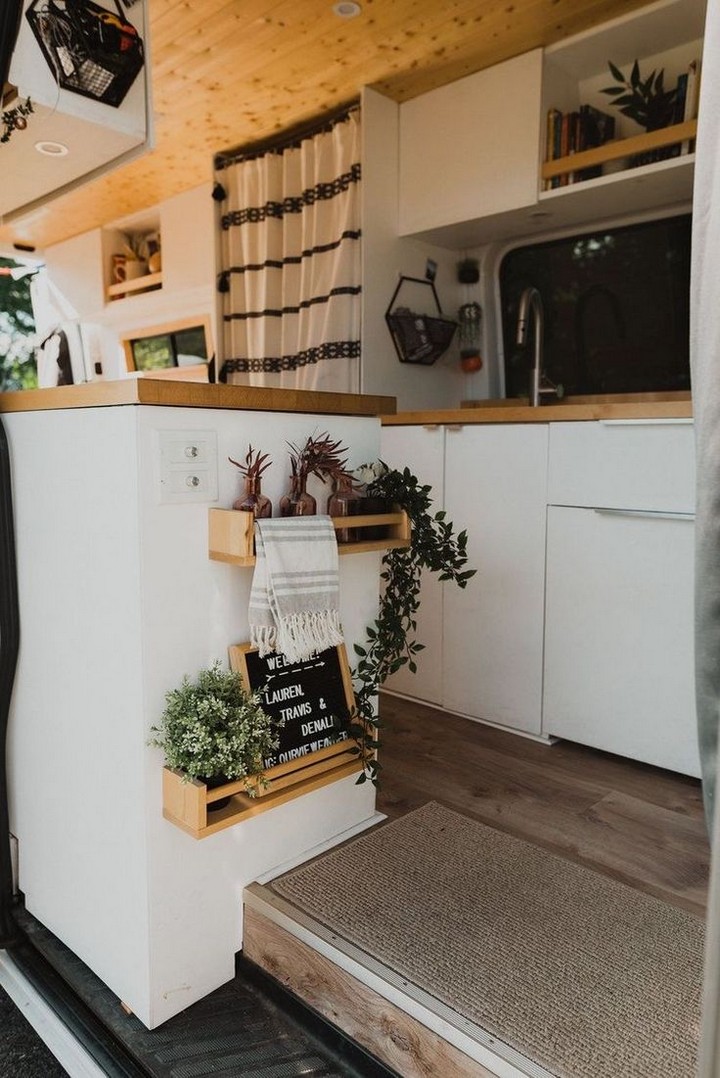
Minimalist vintage carefully incorporates select period pieces within an otherwise minimal framework. Rather than filling spaces with collectibles, this aesthetic selects one or two statement vintage items that become focal points against a clean backdrop. Mid-century furniture pieces often work particularly well in van conversions due to their typically compact dimensions and emphasis on functionality. These conversions balance nostalgia with contemporary sensibilities, creating spaces that feel timeless rather than tied to a specific era. The approach adds soul and character while maintaining the spaciousness of minimalist design.
13. Mediterranean Minimalism
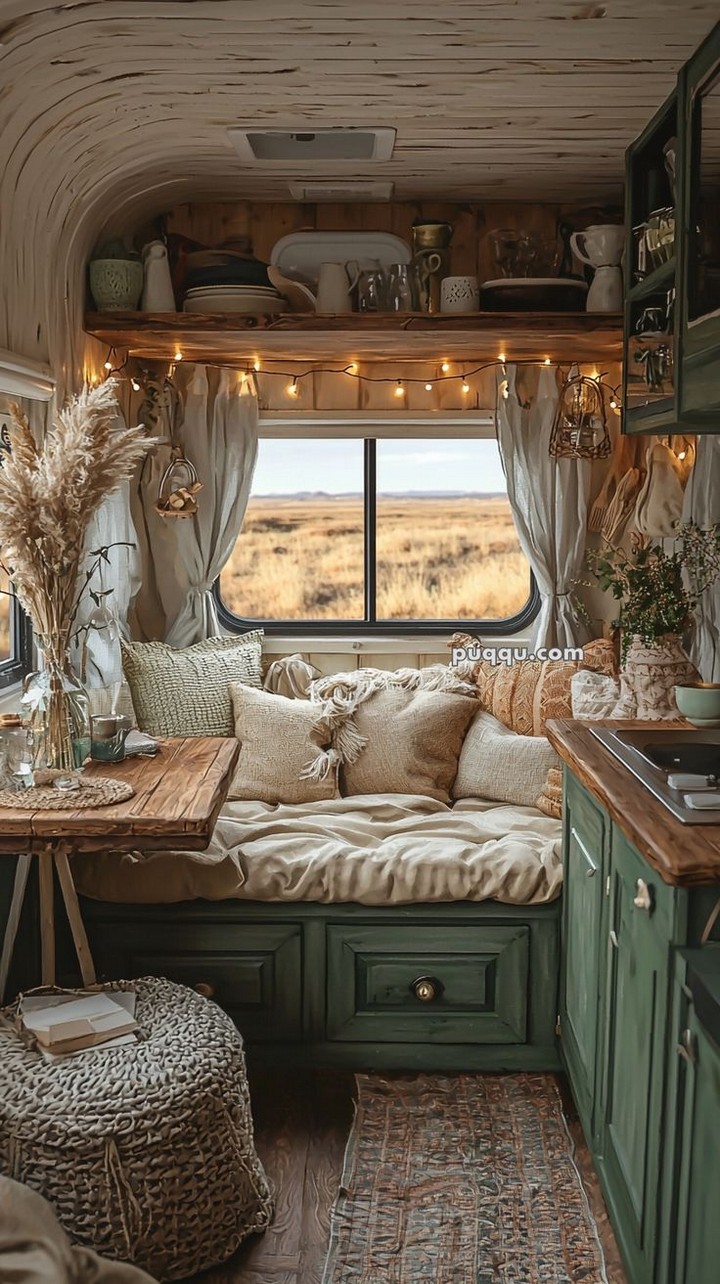
Mediterranean minimalism captures the essence of southern European coastal living through a pared-back lens. White walls create a sun-bleached backdrop reminiscent of seaside villages, while terracotta, azure blue, and olive green add subtle color connections to the Mediterranean landscape. Textures tend toward rustic and natural—think rough plaster finishes and handwoven textiles. Curved forms soften the space, echoing the organic architecture of Mediterranean buildings. The overall effect is airy and timeless, evoking relaxed coastal living while maintaining minimalist principles.
14. Desert Modernism
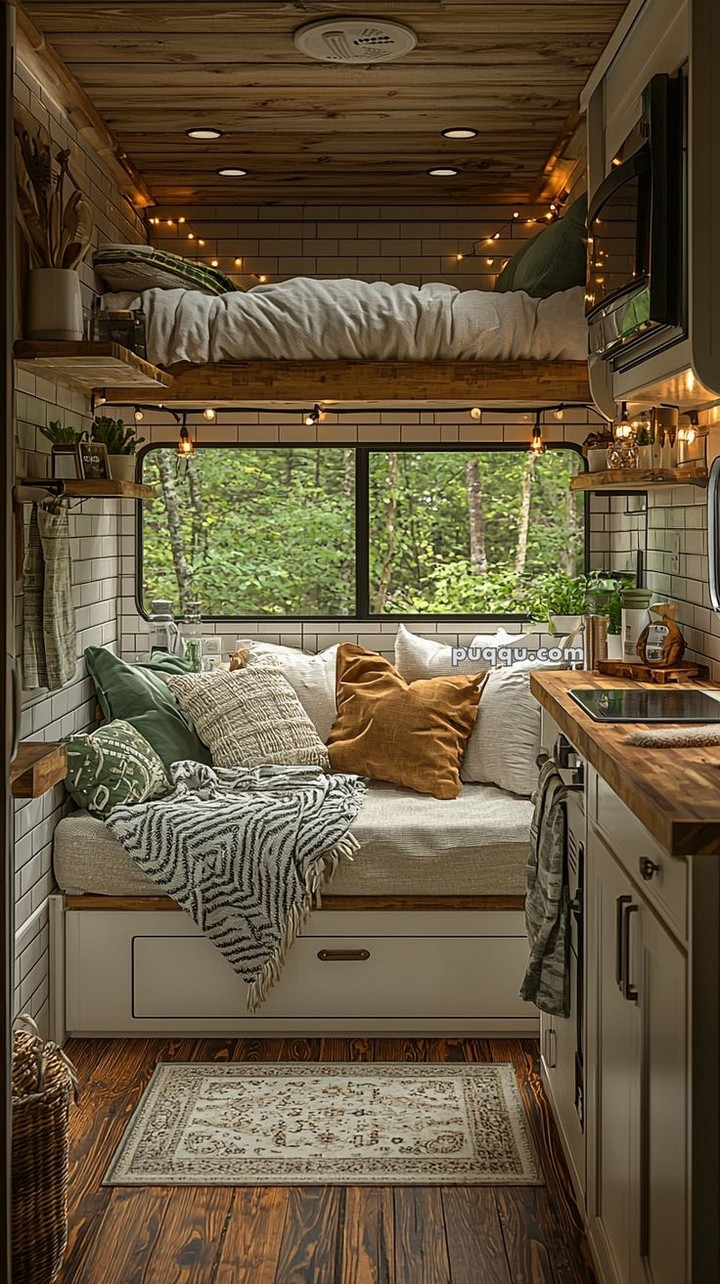
Desert modernism translates the stark beauty of arid landscapes into interior aesthetics. The color palette mimics desert environments with sandy neutrals, terracotta, and subtle sage greens. Natural and heat-resistant materials like leather, terra cotta, and sustainable woods create a connection to desert environments. Geometric patterns might reference Indigenous desert art or abstract desert landscapes. The aesthetic balances warmth and coolness, creating spaces that feel protected from imaginary heat while remaining open and minimal. These conversions particularly suit travelers who frequent desert regions and want their interior to harmonize with these landscapes.
15. High-Tech Minimalism
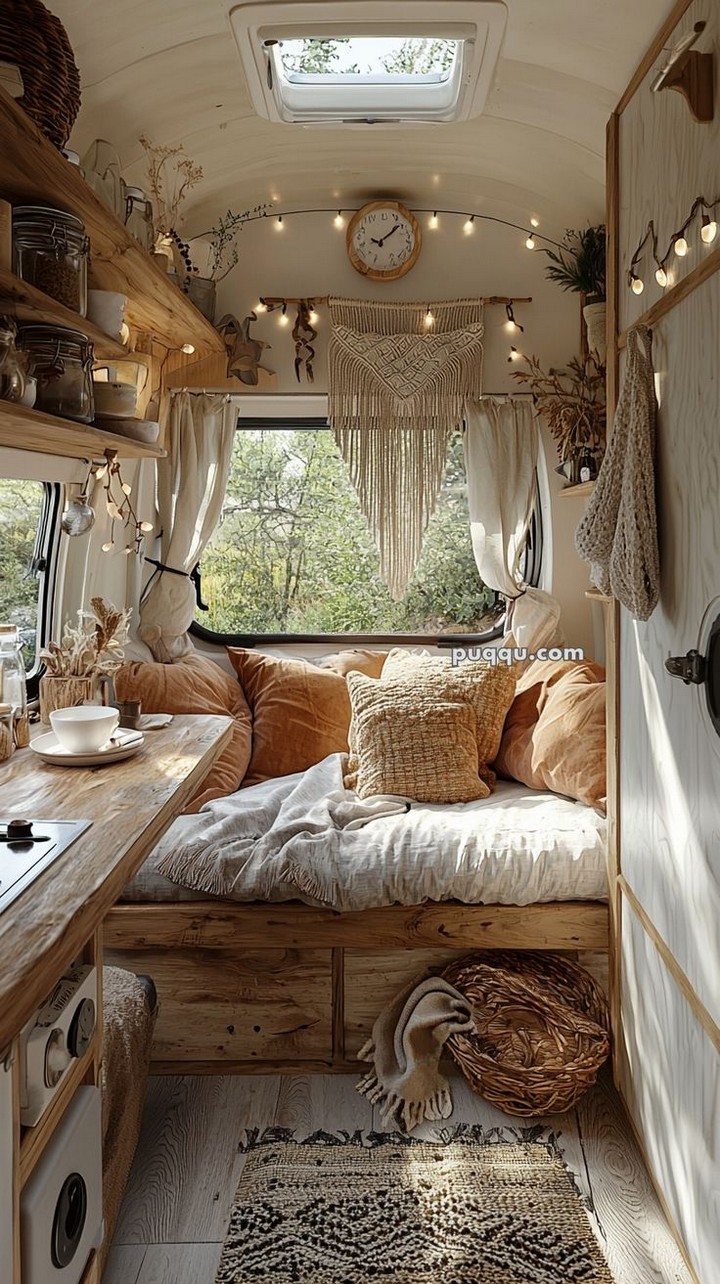
High-tech minimalism integrates smart technology seamlessly into clean design. Technology becomes invisible when not in use, with cleverly hidden charging stations, retractable screens, and automated systems. Materials tend toward the contemporary glass, polished metal, and high-performance composites. The color palette often features cool tones with dramatic lighting effects that can be adjusted to change the atmosphere. These conversions emphasize the futuristic possibilities of small spaces, demonstrating how technology can enhance rather than complicate the minimal van lifestyle.
16. Warm Minimalism
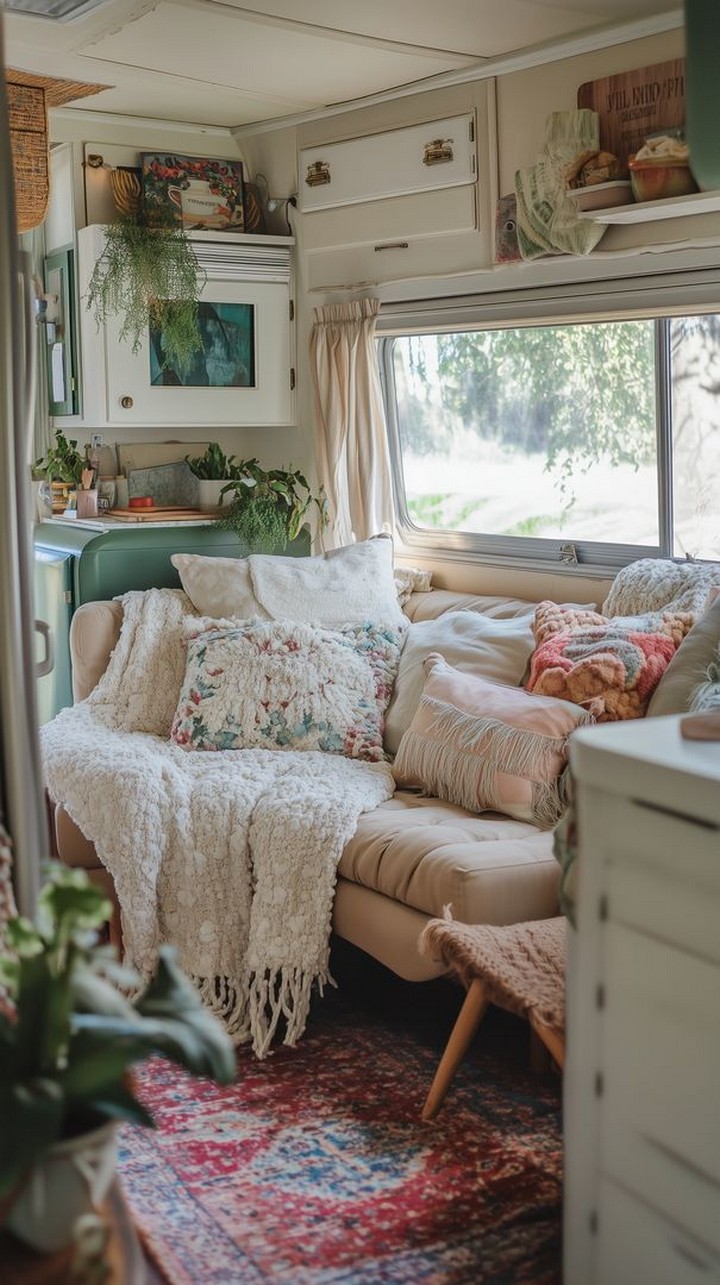
Warm minimalism counters the perception that minimalist spaces must feel cold or clinical. Rich, natural materials like honey-toned woods and leather develop character with age rather than requiring replacement. The color palette focuses on warm neutrals—creams, tans, and warm grays with selective use of deeper hues like terracotta or mustard. Texture becomes crucial in these spaces, with layers of natural materials creating visual interest without clutter. Lighting emphasizes warmth through both fixture design and bulb temperature. These conversions feel immediately welcoming and lived-in while maintaining minimalist principles.
17. Organic Minimalism

Organic minimalism emphasizes natural forms, materials, and connections to the outdoor environment. Curved lines replace rigid geometry, creating a sense of flow throughout the space. Materials maintain their natural character and are often locally sourced. The color palette draws directly from nature, with forest greens, sky blues, and earthy browns creating a seamless transition between outdoor environments and the van interior. Large windows or strategic skylights blur boundaries between inside and outside. These conversions particularly appeal to nature enthusiasts who want their interior space to complement rather than contrast with the landscapes they explore.
18. Art-Focused Minimalism
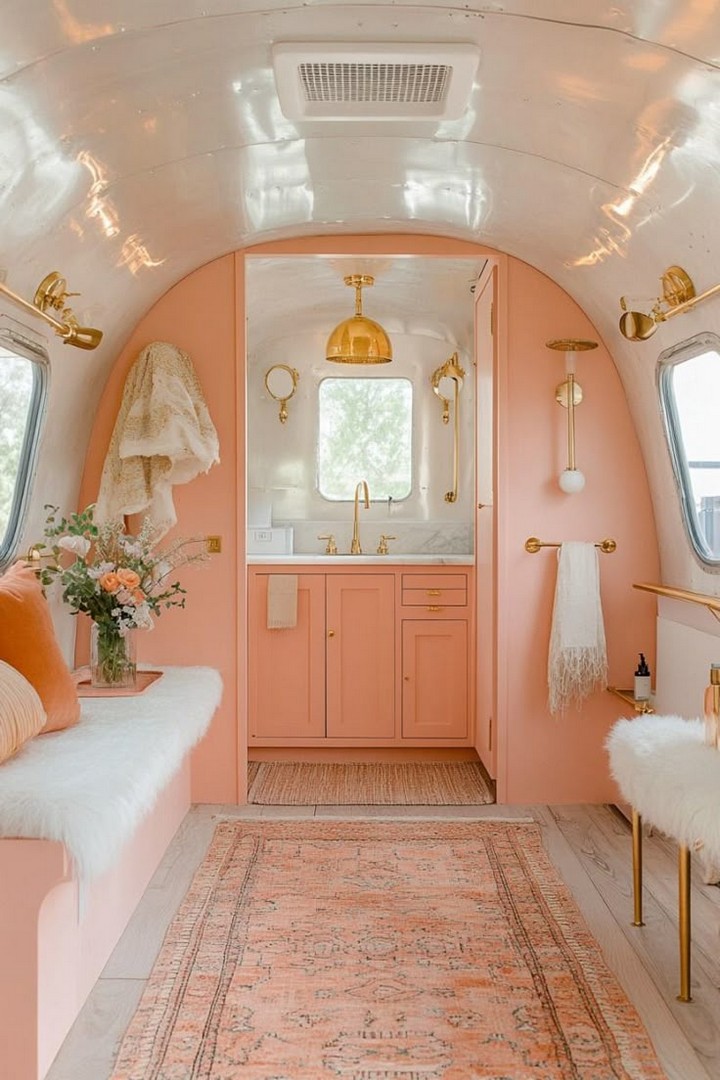
Art-focused minimalism creates gallery-like spaces where select meaningful artwork becomes the focal point. Clean, neutral backgrounds allow art pieces to command attention without competition. Art integration might include rotating display systems to allow travelers to change their visual environment without adding clutter. Lighting is carefully planned to showcase art pieces effectively. These conversions demonstrate that minimalism doesn’t mean abandoning self-expression—rather, it creates space for intentional expression through carefully chosen pieces that carry significant personal meaning.
19. Tonal Texture Minimalism
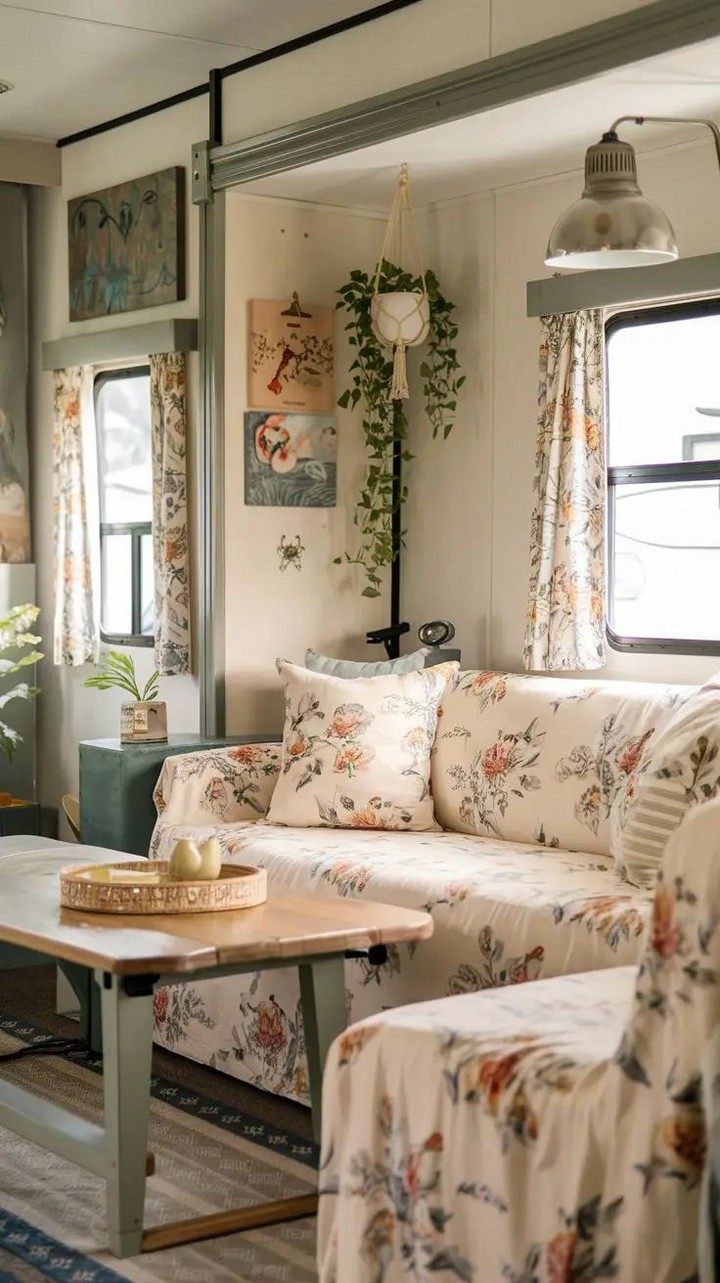
Tonal texture minimalism creates interest through variations in material finish rather than color contrast. Similar tones in different materials and textures create subtle visual complexity that rewards close attention. Materials might include matte and polished versions of the same finish, or different materials in very similar color tones. The approach creates spaces with depth and interest while maintaining a cohesive, calming aesthetic. These conversions demonstrate sophisticated restraint, proving that visual interest doesn’t require bold color contrasts or numerous decorative elements.
20. Functional Luxury Minimalism
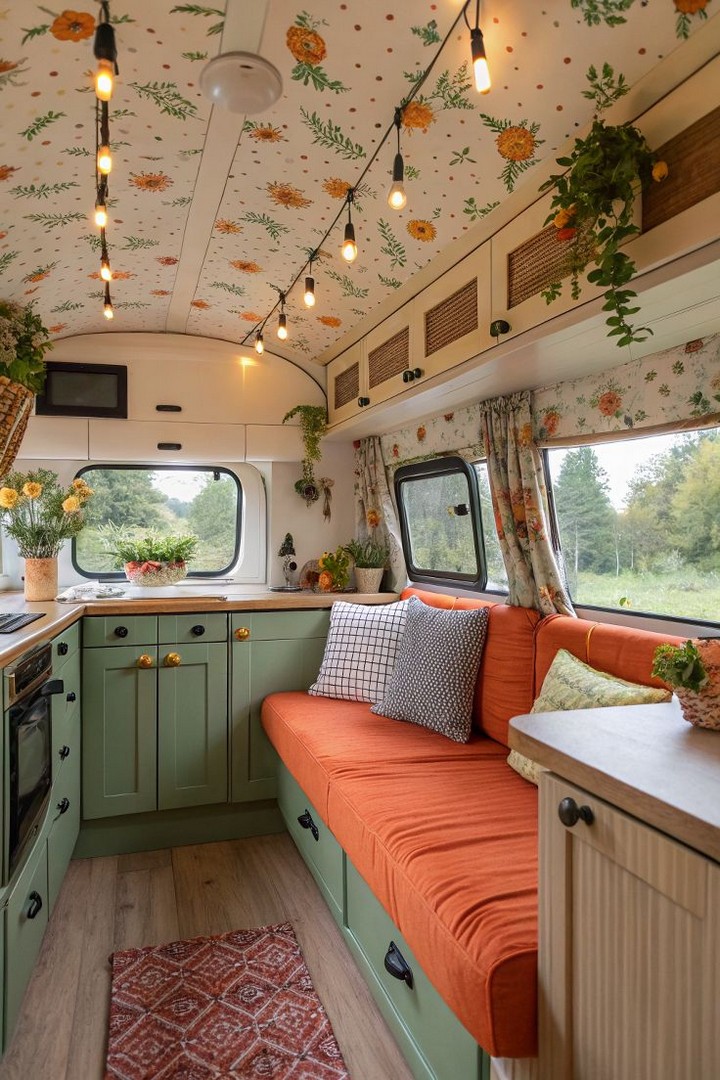
Functional luxury minimalism focuses on quality over quantity, investing in fewer but exceptional pieces and finishes. Premium materials are used selectively where they’ll have the most impact perhaps for seating surfaces or key hardware touchpoints. Hidden storage solutions maintain clean lines while accommodating necessities. Environmental controls and lighting are optimized for comfort and ambiance. These conversions demonstrate that minimalism isn’t about deprivation but about making room for true luxury space, quality, and thoughtful details that enhance daily experience.
21. Geometric Minimalism
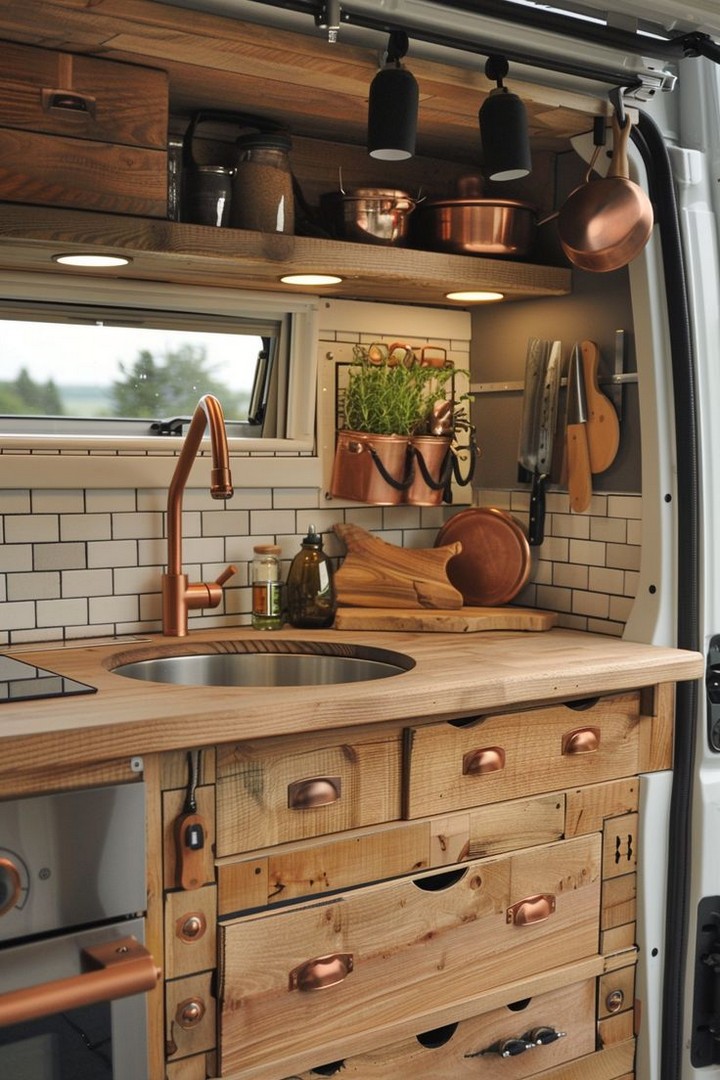
Geometric minimalism uses clean, precise shapes and patterns to create visual interest within a minimal framework. Subtle geometric details in cabinetry, textiles, or built-in elements add sophistication without overwhelming the space. The approach often emphasizes perfect proportions and mathematical harmony in the layout. The color palette typically remains restrained, allowing the geometric elements to provide visual interest. These conversions feel particularly ordered and intentional, with every element precisely placed according to an overarching geometric concept.
22. Intentional Nomadism

Intentional nomadism embraces the mobile nature of van life through design choices that celebrate rather than disguise transition and movement. Flexible furniture arrangements accommodate different needs throughout the day. Storage solutions are designed for items in transit rather than static collections. Materials and finishes are selected for durability and adaptability to different environments. Maps, journey documentation, or location-inspired elements might be incorporated into the design. These conversions honor the essence of van life movement, adaptation, and changing perspectives while maintaining the clarity and intention of minimalist design.
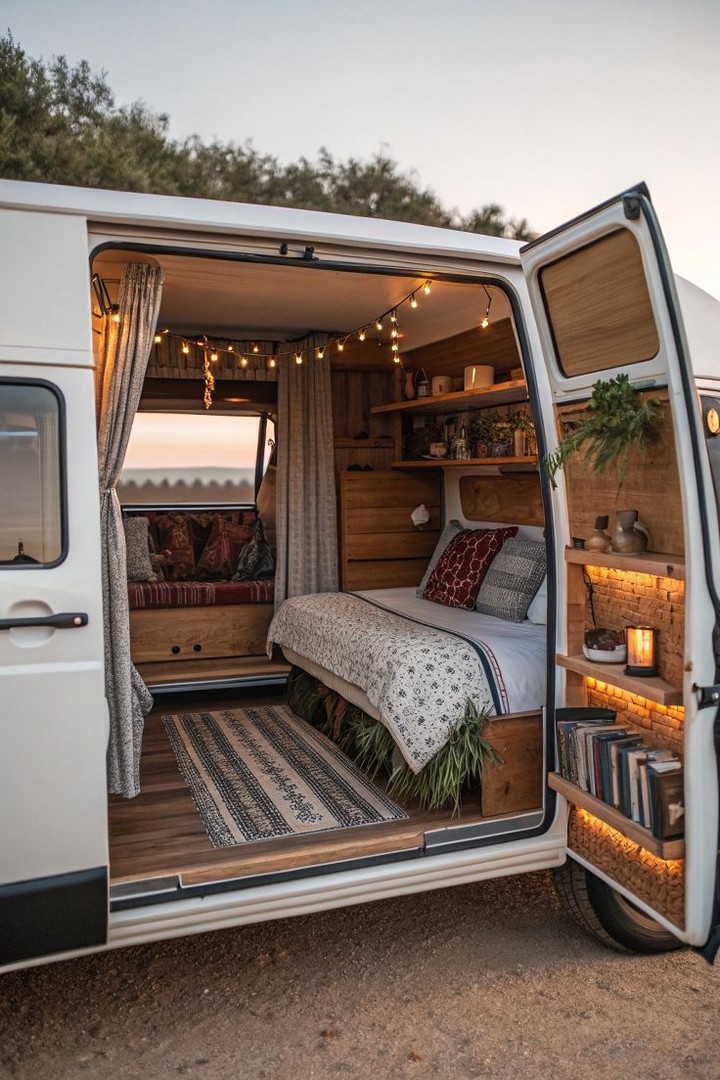
The beauty of minimalist van design lies in its adaptability to personal preferences and practical needs. The 22 aesthetics outlined above offer starting points rather than rigid formulas. Most successful van conversions ultimately blend elements from multiple aesthetics to create spaces that perfectly match their owners’ lifestyles, travel patterns, and personal tastes.
When developing your van’s minimalist aesthetic, consider not just how you want your space to look, but how you want it to feel and function. Think about the environments where you’ll typically travel and how your interior might complement them. Consider your daily routines and ensure your aesthetic choices support rather than hinder them.
Remember that true minimalism isn’t about deprivation or aesthetic purity for its own sake—it’s about creating space for what truly matters to you, whether that’s comfort, creativity, connection to nature, or the freedom of the open road.
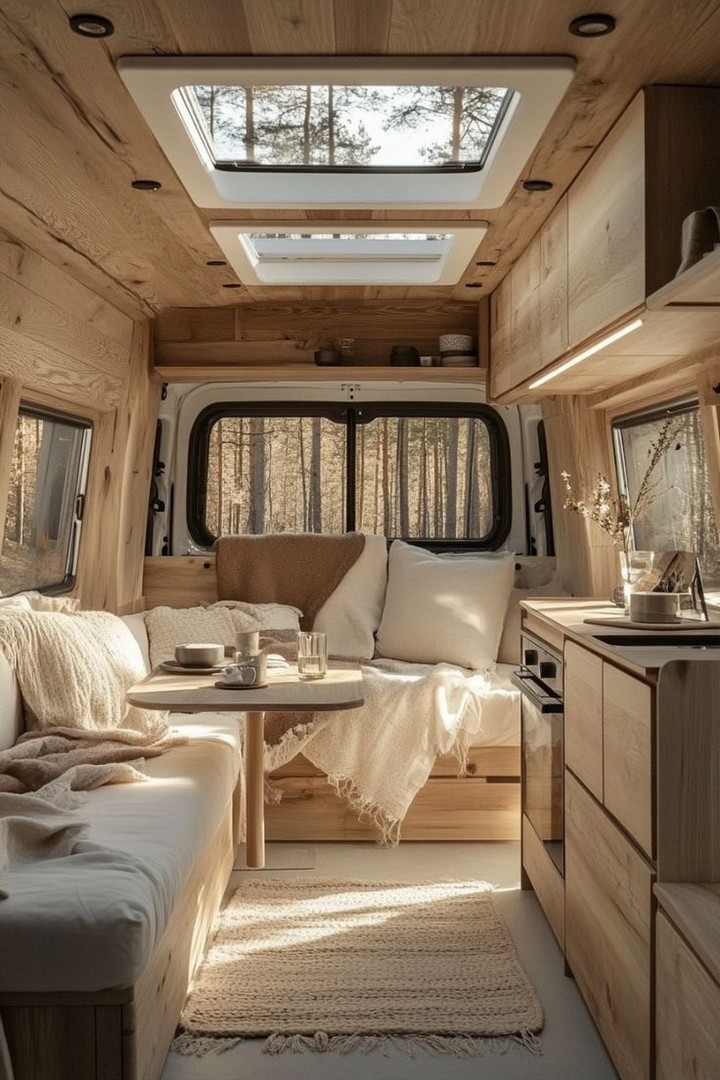
Have you converted a van using one of these minimalist aesthetics, or are you planning a conversion that combines several approaches? We’d love to hear about your experiences and see your creations! Share your stories in the comments below, or tag us in your social media posts to inspire others on their van conversion journeys.
Looking for more practical advice on implementing these aesthetics? Explore our related articles on space-saving storage solutions, sustainable materials for van conversions, and essential tools for DIY van builders. Your perfect minimalist mobile sanctuary awaits!
With these concepts, you can build a van that’s as functional as it is beautiful. Happy converting! 🚐💨

